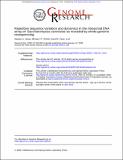| dc.contributor.author | James, Stephen A. | |
| dc.contributor.author | O’Kelly, Michael J. T. | |
| dc.contributor.author | Carter, David M. | |
| dc.contributor.author | Davey, Robert P. | |
| dc.contributor.author | Oudenaarden, Alexander van | |
| dc.contributor.author | Roberts, Ian N. | |
| dc.date.accessioned | 2013-02-06T21:29:58Z | |
| dc.date.available | 2013-02-06T21:29:58Z | |
| dc.date.issued | 2009-01 | |
| dc.date.submitted | 2008-08 | |
| dc.identifier.issn | 1088-9051 | |
| dc.identifier.uri | http://hdl.handle.net/1721.1/76761 | |
| dc.description.abstract | Ribosomal DNA (rDNA) plays a key role in ribosome biogenesis, encoding genes for the structural RNA components of this important cellular organelle. These genes are vital for efficient functioning of the cellular protein synthesis machinery and as such are highly conserved and normally present in high copy numbers. In the baker's yeast Saccharomyces cerevisiae, there are more than 100 rDNA repeats located at a single locus on chromosome XII. Stability and sequence homogeneity of the rDNA array is essential for function, and this is achieved primarily by the mechanism of gene conversion. Detecting variation within these arrays is extremely problematic due to their large size and repetitive structure. In an attempt to address this, we have analyzed over 35 Mbp of rDNA sequence obtained from whole-genome shotgun sequencing (WGSS) of 34 strains of S. cerevisiae. Contrary to expectation, we find significant rDNA sequence variation exists within individual genomes. Many of the detected polymorphisms are not fully resolved. For this type of sequence variation, we introduce the term partial single nucleotide polymorphism, or pSNP. Comparative analysis of the complete data set reveals that different S. cerevisiae genomes possess different patterns of rDNA polymorphism, with much of the variation located within the rapidly evolving nontranscribed intergenic spacer (IGS) region. Furthermore, we find that strains known to have either structured or mosaic/hybrid genomes can be distinguished from one another based on rDNA pSNP number, indicating that pSNP dynamics may provide a reliable new measure of genome origin and stability. | en_US |
| dc.language.iso | en_US | |
| dc.publisher | Cold Spring Harbor Laboratory Press | en_US |
| dc.relation.isversionof | http://dx.doi.org/10.1101/gr.084517.108 | en_US |
| dc.rights | Creative Commons Attribution Non-Commercial | en_US |
| dc.rights.uri | http://creativecommons.org/licenses/by-nc-sa/3.0/ | en_US |
| dc.source | Genome Research | en_US |
| dc.title | Repetitive sequence variation and dynamics in the ribosomal DNA array of Saccharomyces cerevisiae as revealed by whole-genome resequencing | en_US |
| dc.type | Article | en_US |
| dc.identifier.citation | James, S. A. et al. “Repetitive Sequence Variation and Dynamics in the Ribosomal DNA Array of Saccharomyces Cerevisiae as Revealed by Whole-genome Resequencing.” Genome Research 19.4 (2009): 626–635. © 2009 by Cold Spring Harbor Laboratory Press | en_US |
| dc.contributor.department | Massachusetts Institute of Technology. Department of Physics | en_US |
| dc.contributor.mitauthor | O’Kelly, Michael J. T. | |
| dc.contributor.mitauthor | Oudenaarden, Alexander van | |
| dc.relation.journal | Genome Research | en_US |
| dc.eprint.version | Final published version | en_US |
| dc.type.uri | http://purl.org/eprint/type/JournalArticle | en_US |
| eprint.status | http://purl.org/eprint/status/PeerReviewed | en_US |
| dspace.orderedauthors | James, S. A.; O'Kelly, M. J.T.; Carter, D. M.; Davey, R. P.; van Oudenaarden, A.; Roberts, I. N. | en |
| dspace.mitauthor.error | true | |
| mit.license | PUBLISHER_CC | en_US |
| mit.metadata.status | Complete | |
